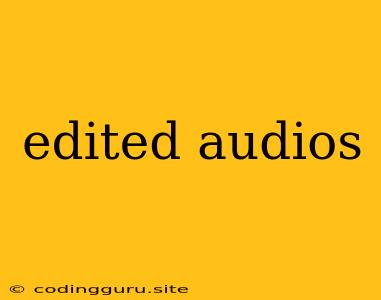The World of Edited Audios: A Comprehensive Guide
Audio editing is an essential skill in today's digital world, with applications spanning various fields. From podcasting and music production to video editing and voice-over work, edited audios play a crucial role in shaping our experiences and communicating our ideas.
But what exactly is audio editing, and how can you master this craft? This comprehensive guide will explore the world of edited audios , covering everything from basic concepts to advanced techniques and the latest trends.
Understanding the Basics of Audio Editing
At its core, audio editing involves manipulating sound recordings to achieve a desired outcome. This can include:
- Removing unwanted noise: Background noise, pops, clicks, and other unwanted sounds can be effectively eliminated, resulting in a cleaner and more polished audio.
- Adjusting volume and levels: By controlling the volume of different elements within an audio recording, you can create a balanced and dynamic sound.
- Adding effects: Various effects, such as reverb, delay, equalization, and compression, can be applied to enhance the audio, create unique soundscapes, and improve the overall listening experience.
- Combining multiple audio tracks: Whether you're layering instruments in a music production or combining different voice recordings in a podcast, editing tools allow you to combine multiple audio tracks seamlessly.
- Creating sound effects: Audio editing software can be used to generate sound effects from scratch, giving you complete control over the creative possibilities.
Tools of the Trade: Exploring Audio Editing Software
The world of audio editing software offers a diverse range of options, each catering to specific needs and skill levels.
Beginner-friendly Options:
- Audacity: A free and open-source software, Audacity is an excellent starting point for aspiring audio editors. It offers a user-friendly interface and a comprehensive set of basic editing tools.
- GarageBand: Apple's free audio editing software, GarageBand is designed for Mac users and provides a simplified, intuitive environment for creating music and podcasts.
Professional-grade Software:
- Adobe Audition: A powerful and industry-standard audio editing software used by professionals in music production, sound design, and post-production.
- Pro Tools: The go-to software for music production and recording, Pro Tools offers an extensive range of tools and features for advanced audio editing and mixing.
- Logic Pro X: A popular and versatile Digital Audio Workstation (DAW) for Mac users, Logic Pro X combines professional-grade features with a user-friendly interface.
Common Audio Editing Techniques
Mastering the art of audio editing requires an understanding of various techniques.
Noise Reduction:
- Gate: This technique automatically reduces the volume of low-level audio, effectively eliminating quiet background noise.
- Noise Reduction Filter: This filter analyzes the noise profile and applies a specific filter to reduce its presence in the audio recording.
EQ (Equalization):
- Boosting and Cutting Frequencies: By adjusting the frequency spectrum of audio, you can enhance certain frequencies while reducing others. This can be used to shape the overall sound, emphasize specific instruments, or correct tonal imbalances.
- High-pass and Low-pass Filters: These filters cut out frequencies below or above a specific threshold, respectively. This can be useful for removing unwanted low-end rumble or high-frequency hiss.
Compression:
- Dynamic Range Control: Compression is used to reduce the dynamic range of audio, making quiet parts louder and loud parts quieter. This results in a more even and balanced audio experience.
- Limiting: This technique prevents audio signals from exceeding a specific threshold, protecting speakers and preventing clipping distortion.
Reverb and Delay:
- Reverb: Creates the impression of a space by adding reflections and reverberation to the audio signal.
- Delay: Creates echoes by repeating the audio signal with a specific time delay.
Creating Edited Audios That Stand Out
Beyond technical skills, creativity and attention to detail are key to producing edited audios that captivate listeners.
Here are some tips for taking your audio editing to the next level:
- Listen critically: Pay close attention to the nuances of the audio and identify areas that require improvement.
- Experiment with different techniques: Don't be afraid to experiment with various tools and effects to find what works best for your audio.
- Seek feedback: Share your work with others and gather constructive feedback to refine your editing skills.
- Stay updated with trends: The world of audio editing is constantly evolving. Keep up with the latest software, techniques, and trends to stay ahead of the curve.
The Future of Edited Audios
The future of audio editing is bright. With the rise of artificial intelligence (AI), advanced audio editing tools are becoming more intuitive and powerful.
- AI-powered tools: These tools can automatically remove noise, enhance vocals, and even generate unique sound effects, making audio editing more efficient and accessible.
- Immersive audio experiences: The development of technologies like binaural audio and spatial audio is creating opportunities for more immersive and engaging audio experiences.
- Virtual and augmented reality: Audio plays a crucial role in virtual and augmented reality applications, enhancing the user experience.
Edited Audios: Conclusion
Edited audios are a powerful tool that can transform raw sound recordings into compelling and engaging experiences. By mastering the fundamentals of audio editing, experimenting with various techniques, and keeping an eye on emerging trends, you can unlock the full potential of this creative craft. Whether you're a seasoned professional or a beginner just starting out, the world of edited audios offers endless possibilities to explore.
